I was extremely fortunate to be invited to Lani Irwin’s home and studio near the Umbrian town of Assisi this summer. Ms. Irwin graciously agreed to an email interview in which she talks about her paintings, process and thoughts on art making. I can’t begin to thank Ms. Irwin enough, not only for her generosity with her time but also the thoughtfulness and eloquence of her words.
One of the most striking aspects of Irwin’s paintings is the compelling, enigmatic nature of her subject matter. In her interview in The Montréal Review, February 2011 Ms. Irwin talks in depth about meaning in her paintings. Since so much has already been written about the narrative and subject matter in her paintings, I wanted to ask questions that centered more around formal painting concerns. However, I quickly realized that separating the formal concerns away from the meaning behind and reasons for making a painting is probably like trying to separate out techniques of child-rearing from a mother’s love for her child.
Painting Perceptions is delighted to share this recent conversation with Lani Irwin and welcomes our new staff writer, Tina Engels, who writes the introduction below and also asks a question at the end of the interview that is of particular interest to women painters.
Tina Engels writes:
Lani Irwin has lived and worked in a small Umbrian town outside of Assisi, Italy, since 1987. Lani and her husband, the painter, Alan Feltus, have maintained a rich reflective life of study, work, family and intellectual community.
Irwin produces paintings that revel in the nuances of an inner artistic privacy and convey the strength of a public voice. Her visual worlds are balanced by an artist’s need to protect some kernel of silence in proportion to the mystery one chooses to explore. Irwin’s paintings savor the subtlety of what is evident and unspoken, contrasted and revealed. The lure of the visual labyrinth lies in depicting contrasting dualities of human consciousness.
All too often the contemporary audience requires much in the way of explanation and revel in the specificity of the narrative. In contrast, Irwin’s paintings preserve the melodies otherwise drowned out by too many words, stories and information.
Gail Leggio in the American Arts Quarterly in 2001 said:
“For a quarter-century Lani Irwin has been painting mysterious interiors populated by mannequins, puppets, toys and human figures. While her dolls are reminiscent of the lay figures Giorgio de Chirico deploys, her hushed tableaux may suggest the domestic enigmas of Balthus. Yet the artists Irwin most admires are not from the twentieth century but from an earlier period, the cusp of the Italian Renaissance. “I love the strange disquiet of some of the paintings,” she writes. “I often do not know the particulars of the story, nor do I need to. And so it is with my own paintings.”
Born in Annapolis, Maryland in 1947, Irwin traveled throughout Europe as a child, studied in Munich and Grenoble, and earned B.A. and M.F.A. degrees from American University in Washington, D.C. She has been exhibiting since the mid-1970s, and examples of her work can be found in the Hirshhorn Museum, the National Museum of American Art and the Corcoran Gallery of Art… Gail Leggio, American Arts Quarterly, 2001 Vol. XVIII, No.2
Joan Markowitz, Co-Executive Director and Senior Curator of the Boulder Museum of Contemporary Art stated:
“Drawing on influences as diverse as Flemish paintings, Oriental rugs, Renaissance frescoes and works by Picasso, Lani Irwin’s paintings are elusive and dramatic. Her figures, interestingly garbed, are most often women, poised for dance or engaged in games of chance and balancing acts; and allude to life’s psychological convolutions and complexities. While they stare out at the viewer assuredly, she has eschewed a particular narrative, and creates complicated and mysterious tableaux of enigmatic symbology, which elude facile interpretation and offer a plethora of mysteries to ponder. Carefully conceived and consummately painted, her skill is manifest in the creation of these beautifully engaging images.”
Larry Groff: What led you to become a painter?
Lani Irwin: Whenever I attempt to speak or write about myself or my painting, it often feels like a work of fiction full of contradictions. I can see my life or my work from multifarious positions, much of it enigmatic and illusory. I remember drawing from a very early age but I think nearly all children draw as a way of understanding or seeing the world they live in, or their own inner life. My memories of childhood are sparse and in them I was involved in pretending, living in an imaginary world, inventing relationships and dialogues. Perhaps a more persistent tendency that could explain my decision to become a painter would be that of wanting to live in fantasy, to escape, creating my own version of reality, or enjoying that which is created by others, be it painting, literature, film, or music. I wanted to be part of that other world. When I lived in Europe, from the age of 15 to 18, I visited many museums and saw extraordinary paintings and sculptures. What I felt when looking at certain paintings was transcendent and transformative, like windows to the soul. When finally it was time to decide what I wanted to study, the only thing that seemed right for me was painting.
LG: What was school like for you?
Lani Irwin: I envy so many painters who have had interesting or even extraordinary experiences with teachers who became mentors. When I think back to my classes, there was little that I can remember of any note, no epiphanies, few revelations about how to paint or who I might be as a painter. I spent many hours in studio classes but I was often unable to relate with enthusiasm to the set-ups or the models or to what was being said to me. However, in my last year of graduate school the fall of 1972. Alan Feltus, newly hired to teach undergraduates, invited some of the graduate students to see his paintings when they arrived from Rome, where he had been the two years previous on a Rome Prize Fellowship (Prix de Rome). The paintings Alan had developed over those two years were for me a rare and impressive merging of the contemporary with the classic. His paintings were personal and individual, quiet but intensely expressive, yet in no way hyped by the need to do something “new”. In the end, once I had finished all my courses, I realised that it was time for me to find my own way, teach myself how to paint. So I put a seagull skull on a box and began working alone from observation. I suppose more than to teach myself how to paint, it was to discover what was important to me in painting and to find my own voice in order to understand what and how to paint.
LG: Was figurative painting something you got into early?
Lani Irwin: I have always been interested in figurative painting. Non-objective painting has never really appealed to me, seeming to leave out so much of what is essential and powerful in painting.
LG: Who were some of your biggest influences? Was there any particular idea or thing you experienced that was especially formative and still shapes you today?
Lani Irwin: In the summer of 1974, Alan and I went to Assisi together for the first time. When I entered the Basilica of San Francesco in Assisi and saw the frescoes of Giotto, Pietro Lorenzetti and Simone Martini, I felt a moment of revelation or insight. After years of trying different approaches to painting from Rembrandt to Bonnard, Vuillard and Soutine, it seemed that what I wanted was something quite beyond my own understanding. What continues to engage me when looking at those frescoes in Assisi seems unknowable. It is the magic, the mystery, what runs under the surface of our very beings, the parts of us that we find so hard to understand. When we walked into the Basilica, I remember saying that I believed there must be a higher power, perhaps a god, something greater than the day to day of ordinary life that could elicit such incredible images. They seem to embody that deep otherworldly atmosphere that dreams are made of, something that carries me into another realm of consciousness and awareness.
LG: How do you go about the planning and beginning work on a painting? How important is balance and tension? Do you use any form of dynamic symmetry or similar?
Lani Irwin: There is no set method. Rarely do I make preliminary drawings, never do I plan out a painting in any formal way. I spend a lot of time staring at the blank canvas. In the end I must just start with something and believe that the next something will reveal itself in the painting of that first something. This requires a kind of faith that the painting itself will take over. What I do is more like choreography, placing objects and figures in relationship to one another to create a tension that interests me. There is no prescription for how this might work best. The selection of the particular objects or the gesture and position of the figures creates a dialogue. Objects speak to me and to one another. It is the dance between these elements rather than a formal consideration of balance or square within a rectangle that orchestrates my paintings and it is driven by intuition.
LG: How much of an idea do you need before you start the painting or does it evolve in the process of working?
Lani Irwin: When you ask how much of an idea do I need, I could say it would be wonderful to actually have an idea when I start a painting. What I usually have is more like the ghosts of a dream after I wake up, that fleeting image that I can’t quite grasp, even when I try to write it down or draw it. So I start with the ghost and from there it does evolve, though not without many stops and starts.
LG: How much does the subject and composition evolve during the painting process? Could you say something about how your painting, La Ruota, evolved during the time you worked on it from 2009-13?
Lani Irwin: The entire process is one of evolution, finding the subject and the composition slowly through the painting of it. With each layer, the interweaving of shapes and colours slowly build to reveal both the subject and the composition, if indeed they are separate entities. The search for the colour is simultaneous with the search for the form. I believe colour is very personal, something inherent and is guided by instinct and intuition. However, because I paint the objects from observation, to some extent, colour is dictated by the object itself. One reason “La Ruota” took so many years was that I painted a few layers to find the positions and relationships of the figures and objects within the space and then didn’t work on it for about a year while I worked on other paintings. If you consider the figures to be the subject, and I am never quite sure of that, then as I redraw and repaint the figures, what is next to them also changes. That is how the composition develops. The doll parts were on a shelf in front of the figures for a long time and the most dramatic change in the composition was when I removed the shelf and suspended the doll parts. Instead of defining a comfortable space in the painting and guiding the viewer into that space, the figures and objects in the painting seemed to be right on the surface, if not pushing out into the space of the viewer. This was not something I planned. The pattern using the shape of an ouroborus on the red wall grew in part from a dream. The verticality of the painting became stronger thus the horizontal panel with stripes. I know the colour of the wheel changed many, many times and was the last thing to change again months after I thought it was finished.
LG: Patterns of checkerboards, stripes, diamonds, circles, etc often show up in the backgrounds, clothing or other elements in your paintings. Where do these patterns come from and what role do you see for them in the painting?
Lani Irwin: I believe we are who we are in spite of attempts to be otherwise. I love patterns and complexity. I know that when I see the ribs and walls and vaults of buildings painted with pattern and image as carefully as the narrative frescoes, the richness of it excites me profoundly. When I am working, often a space between two shapes cries for more than just a colour so I look for stripes or patterns. However, it is more than just a compositional necessity. Perhaps there is a symbolic aspect to checkerboards and stripes, something that is a part of a universal inner language, that I relate to without a conscious knowing. I love nature, the black and white of the feathers of a hoopoe, the polka dots of a guinea fowl, the surprising patterns of moths and beetles, and shells. For decades I have collected and used patterns from the walls and floors of churches. I have a book of antique hand painted game boards that I have used as a source. Targets, both antique shooting gallery targets and ordinary paper targets, are among my lexicon of possibilities. There is a kind of playful nature in these patterns juxtaposed against one another for no apparent reason other than my own whim. I like visual complexity, multiple layers conjoined.
We seem to be dancing around the discussion of subject matter in my paintings and for me, composition, colour, pattern and subject matter are so thoroughly entwined and interdependent that they are inextricable. When I find myself speaking about targets and patterns, I can’t avoid beginning to question what I am doing with all of this unrelated stuff. Why do I continue to bring many of the same characters together. I had started to say the targets have entered recently but then I remembered that I painted targets and shooting galleries decades ago. Yes, I have used them more frequently recently, but they are not new to my work. Nor is the strangeness of combining seemingly unrelated objects and figures. The paintings of the early Renaissance that I love have stories and symbols so they do carry a more specific meaning that is entangled within the complex visual language. Mine do not have that more specific story or framework to hold it together, give it meaning. I would love it if they did. Perhaps that is what they are about, that loss of what I could call a tangible inner world, a clearer manner of relating to the world we live in that was once accomplished through shared cultural norms. In the rush for what is called progress, we seem to have been left without a language we can all understand. I am not a religious person but I do believe that there is more to life than buying and selling. Nor am I an intellectual painter, one who thinks in abstractions or concepts. I am much more rooted in emotion and intuition. The subjects I am drawn to, the relationships within the paintings that I tend towards creating, seem to have an element of disquiet that can at times be unsettling to viewers. I often go through days where feelings of alienation, aloneness and a strange deep inner sadness seem to take hold of me from an undefined and non-specific place. I paint objects and figures, shapes and patterns that don’t quite reveal themselves, regardless of how I paint them, and certainly don’t explain why they are there together on the same stage, not even to me. A theatre of the absurd.
LG: Is getting a naturalistic sense of light and space in your painting important to you?
Lani Irwin: It seems to me that the light in the “Deposition” of Rogier Van der Weyden emanates from within rather being than observed from without. It is not literal. That kind of light interests me more than a more naturalistic light. And for me, the concept of space is far less important than the interlocking figures and shapes within the borders of the image. Although I am often looking at objects, I am combining them with elements not observed. Since the composition is composed of observed and imagined elements, the light and space are both observed and imagined.
LG: How did you first meet your husband, the painter Alan Feltus? Can you say something about your life with him in Assisi?
Lani Irwin: As I said above, Alan and I met in Washington DC in 1972. We have been together since the beginning of 1973. When Alan was given tenure at American University, we moved to southern Maryland. We renovated a small farm house, planted a garden, had goats and chickens, and converted a good sized tractor garage into our studio. Our two sons, Tobias and Joseph, were born while were living there. Alan resigned his teaching position in 1984 in order to paint full time and in 1987 we decided to spend a year in Italy. We bought a stone ruin of a house in the hills above Assisi and after that year was over, we decided to remain in Italy. We would go back for shows or at times for family, and occasionally for teaching, often trying to combine all three in one trip. In many ways our life here is much as it would be anywhere in that we are painters so we paint most days. Living in Italy more or less allows us to live and paint with little regard for the whims of what is referred to as the art world. Sometimes we are sorry to miss shows and we do miss friends. But as compensation, we can drive in any direction for a short while and find extraordinary paintings, or just look out the window and see spectacular landscape. And many of our friends, both new and old, make their way to Italy so we are able to see them here. It is paradise in many ways.
LG: When I was leaving your home for Venice this summer you surprised me by saying many of the later Venetian painting, like Titian, Veronese, Tintoretto didn’t hold your interest like the earlier Bellini and Carpaccio. What are some reasons you favor much of the early renaissance painting over late renaissance, mannerist and baroque painting?
Lani Irwin: I shudder that I should say such a thing. They are all incredible painters. To respond to your question, though, perhaps it is the unreal nature of the paintings of the Medieval and early Renaissance that appeals to me. Even though they depict stories and ideas, I feel a soulfulness or otherworldliness in them. The figures and architecture are bound together in the early paintings, weaving a web of patterns and shapes that, taken as a whole, create a metaphysical reality, transcending time and the physical nature of the things being depicted. These artists were not concerned with realistically painted figures in credible spaces. In some ways they are more like puzzles, each beautiful piece fitting together as no other piece could fit, orchestrated by the artist’s vision. Light seems to originate from some inner source instead of being dramatic light or light to define form. Later paintings of the Renaissance and Baroque tended to be more involved in the rendering of surfaces and in the overt drama of the stories or incidents or persons depicted. Too many cues were given as to how I ought to respond. When I stand in front of many of these later paintings, it is as if the painters are speaking a language with too many adjectives and adverbs added. The heart and soul seem hidden from me in extravagance, replaced by a kind of virtuosity of paint. Ambiguity and a hushed disquiet is more interesting to me.
LG: Post-modernism would seem to have pushed aside many basic Modernist tenets such as paintings should never be illustration. Painters like John Currin or Lisa Yuskavage blur the line between Illustration and Painting, Peter Schjeldahl stated in a 2003 New Yorker review (http://www.newyorker.com/magazine/2003/12/15/irresistible-2) “…However, judging from his sudden prestige, [Currin’s] example has changed the climate of expectation in contemporary art. He has rehabilitated fallen practices of visual storytelling, restoring to painting its ancient functions of illustration and rhetorical persuasion.”
Paintings show just one frame and can’t tell a story visually like an animation or graphic novels. Would painting today be better off being more abstract and formal–sticking to painterly concerns and leave the narrative to mediums better suited to storytelling? What do you think about the line between illustration and painting today?
Lani Irwin: To some extent, I think the Modernist tenets such as paintings should never be illustration, or that there ought not to be narrative of any sort may well have set many of us back, causing unnecessary struggles as we tried desperately to deny what was present all the time. It seems to me that even painting a table with objects is telling a story. The objects have life of their own and have relationships. Figures just by their very nature imply something beyond the borders of the painting itself. In order to sound “modern” I have said over and over that there is no narrative in my paintings, that the objects are selected for how they work as shapes within a painting even though in some hidden recesses I knew that none of those denials were entirely true. It is true that in my paintings there is no specific, predetermined narrative, and that the objects elicit a personal response for me that they may not elicit in someone else. But there is more to it than just the purely formal and visual. I don’t think painters as a whole ever stopped painting “narrative paintings”. Strictly speaking, the Medieval and early Renaissance paintings I love are illustrations that were painted to instruct and tell stories in a time when few people could read. It is more an issue of whether the “illustration” goes beyond just that specific story, giving it enduring and universal meaning. Painting is not better off being more abstract and formal. Painting needs to continue to strive for that excellence of craft and conviction that has served painters throughout history so well, all the way back to the cave painters. I love film and my sons have both made wonderful animations and films, constructing them with great care visually, much as they would a painting. There are many important film makers. But the ability of film or graphic novels to employ many sequential frames to tell a story doesn’t supplant painting as an art that weaves within itself narrative, whether specific or more ambiguous and personal. The stillness, the unchanging quality of a painting is a strength, allowing a different kind of interaction, perhaps a more profound contemplation.
LG: One thing you wrote in your eloquent response to the 2009 interview with the Montreal Review about your work that particularly resonated with me was what you said about beauty;
“… I believe that beauty is something we all crave, that it is an essential element in art. That said, beauty is not a characteristic or concept that we could all agree about or describe definitively. It is a subjective experience. It is something that elicits a physical response, a feeling of breathless engagement and wonder.”
What makes for the most beautiful things in painting, in your eyes?
Lani Irwin: Oh, this seems an impossible question to answer. What is in both the Soutine “Pastry Chef” in the Barnes Collection and the Lippi “Portrait of a Woman and a Man” at the Metropolitan Museum that cause that kind of wonder for me? Why do I feel that wonderment when I look at the Van der Weyden “Deposition” and the Uccello “Battle of San Romano”, a self portrait or still-life by Dick Ket and a painting by Fausto Pirandello? It must be a bit like falling in love, unpredictable in so many ways yet awe inspiring. Something inside me moves or perhaps it is that I find myself holding my breath. I am closing my eyes and trying to find the words to describe it, but I just can’t. There are many painters working today who can render exquisitely but I don’t feel that breathless engagement as if we have connected over time and space through some universal language. And there are painters who carve out their forms with brushes laden with colour, creating a world sometimes playful, sometimes full of pain, without the refinement of exquisitely rendered form in light, yet I find these paintings full of that same awe inspiring “beauty” that I find in the Lippi or Van der Weyden. In fact, it is important to understand that beauty for me has nothing to do with pretty or pleasant and might be better described as awe. A truly impossible question to answer would be how it relates to my own work. In rare moments I may step back and feel something akin to that awe when looking at something I have done. But in truth, it is a constant struggle to keep looking and painting and hoping that one day, if I work hard enough, in some small measure there might be that kind of beauty in my own work.
LG: What are the most important things you try to get across to students whenever you lecture or teach?
Lani Irwin: There are no shortcuts, there is only the hard work and most important, there really is nothing new in art, nothing that hasn’t been done in some way or another, other than what is written on one’s own soul. I don’t believe that novelty should be what art is concerned with. Novelty is more of a commercial issue. What makes art interesting and sometimes great is seeing the world through the eyes and heart of another, feeling things we might not otherwise have felt. And I use the word feel instead of understand because I think often we don’t really understand, we experience a rush of something incomprehensible but wonderful. Not always pleasant but certainly worth noting. An artist spends much of his or her life out on the edge, never really comfortable because there are no rules about making art that really help. Even now after years and years of trying to make paintings, each time a new painting is begun, it is as if I have no idea of how to paint. We struggle our whole lives against our limitations. And sometimes, many times, I question why. But it is part of who I am, this strange battle of selves.
Tina Engels: There is a clear message from the culture industry to portray the female figure with image alterations that become “perfect” distortions. Post Production manipulation facilitates the creation of accepted formulae of beauty. Your figures have the power to disrupt and challenge contemporary clichéd notions of beauty, do you intend for them to do this? And can you discuss the role of the female nudes in your paintings, how might this fit into a wider context of our culture’s beauty norms?
Lani Irwin: What do I intend for the female figures in my paintings to do? What role do they have? I think I have succeeded in hiding this from myself partially because of the dictates of modernism that eschew the personal in art. On the other side, there is the fear that if I can verbalise what I am doing, it will dilute it or even invalidate it or that it would become illustration in the pejorative sense. Once upon a time I thought it was personal expression that made painting great. Then art education entered and somehow convinced me that painting is about the abstract and formal elements and that it is good and proper to be ignorant of the underlying content of one’s own paintings. As I write that, it sounds a bit like teaching good manners. You are asking me to delve into something I have assiduously avoided for decades, This means trying to come to terms with it myself in order to speak to someone else about it. First and foremost, let me say that I don’t think any of us really ever know ourselves, what goes on in our most private realms, our innermost being. So I often speak in terms of dream worlds, ambiguity, intuitive responses to the unknown recesses of myself. That protects me. Choosing to paint female figures seems a natural thing for me to do because I am a woman and in some way my paintings are about myself, my place in the world. When I do paint male figures, it raises issues of relationship, complicates the psychology of the painting for me. For instance, when I was painting “La Ruota”, I was looking at my son, Tobias, for the male figure. I started to worry that the painting had some kind of influence or prophetic role so I wanted the male figure to have a kind of protective or inclusive gesture towards the female figure, to nourish the relationship. I wanted his relationship to flourish. Magical thinking. Foolish, but it became somehow real for me. This complicity between the painting and real life was complicated by that duality. So I tend to paint female figures and often one female figure. This places more focus on the singularity of presence and intensity of expression within the relationship with the other objects or the space. The figures are not meant to be sensual. When they are left nude, it is partially because I am caught up in the beauty of painting the figure and find no reason to clothe her. Certainly there is a strong element of vulnerability as one feels they are actually undressed. This does differentiate them from nudes that are painted for their sexuality or for ironic purposes or in mythological tales. The strength of the outward gazes keeps the viewer at a distance. The combination of an absence of sexuality and the strength with vulnerability may cause confusion in the viewer because I am belying the anticipated reading of the nude. However, I think it is consistent throughout my work, whether the figures are nude or clothed. By their stance or gesture, the figures protect themselves from intrusion and reside in an environment that is unexplained with objects that are equally enigmatic. What does any of this have to do with the contemporary world? From certain perspectives, absolutely nothing. Yet does it in some way elucidate the disengagement many of us feel? Or does it address the need for protection from the deleterious effects of the culture industry? I am concerned with these issues though I don’t think about them consciously when I am painting. Could my paintings “disrupt and challenge contemporary clichéd notions of beauty”? I would doubt it since precious few of those who fall prey to the lures and seduction of that kind of cultural distortion would be seeing my paintings. Intention means having an aim or plan and until you asked this question, I had not even considered it as a possibility much less an intention. Would that it could.
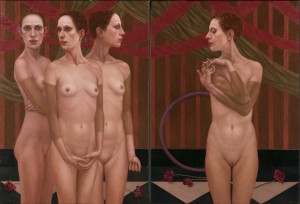
Off Center (or Three Damsels at the Ball with an Insistent Cloakroom and Brief Lessons in Stagefright), 2004, (diptych), 43 ¼ x 66 in, oil on linen
However, the idea that paintings such as mine might have some impact on social norms is interesting though unlikely. Our world is bombarded with mass produced, manipulated images effectively creating a value system wholly removed from what I consider meaningful, beautiful or real. So much is intended to convince the public what or who is beautiful and that the acquisition of material goods is the road to the pursuit of happiness. When I occasionally look at a magazine, I am fascinated by the strange presentations of the models and their clothing that creates an effect without actually revealing what they are trying to sell. Image rather than substance. Name brand instead of quality product. Ideology created by publicity genius. It must be so difficult for younger people to wade through this mire of overstimulation and hyper advertisement. I know when I have spoken to students about my paintings while showing slides, many of the young women have been interested in my work, how I paint the female figure. Rather than think about what the actual paintings might be showing them, I have tended to think it was more to do with the fact that I am a woman who has succeeded in painting for more than forty years, even while raising two children. I have talked about the importance of the personal vision, not getting caught up in trends and fashion. But what my work might have to do with some wider context of beauty norms, never. Certainly the limited audience would preclude any grand effect. But more than that, the thought had just not occurred to me. I do want people to respond to my paintings. I have not ever considered how they might respond or what they might respond to. I contented myself with painting what I was interested in painting, aware that the paintings seemed unsettling to many. Now I must consider the possibility that it is that very confusion and discomfort that I am wanting in the paintings. And that may well reflect my own existential state of being, even at my age.

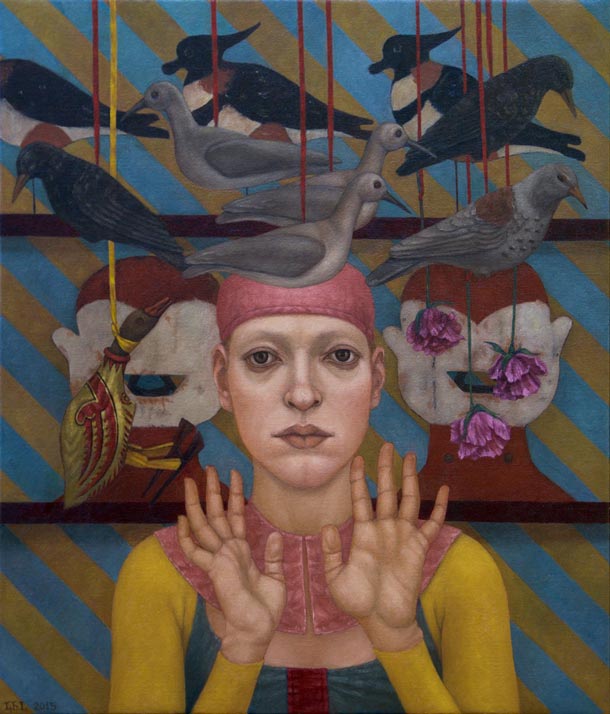
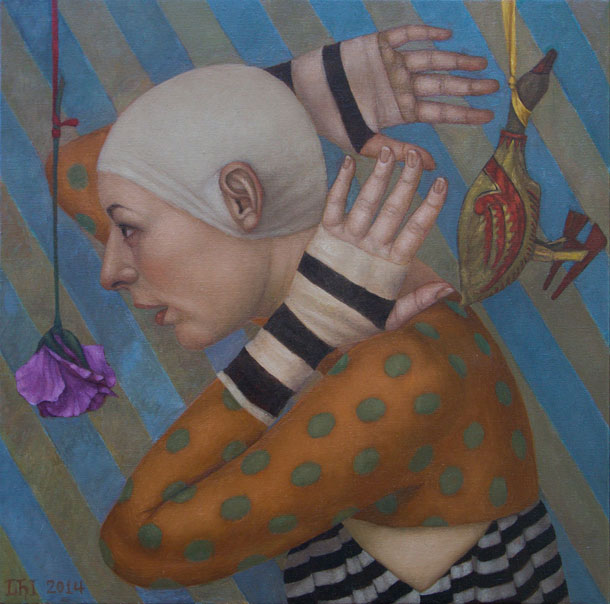
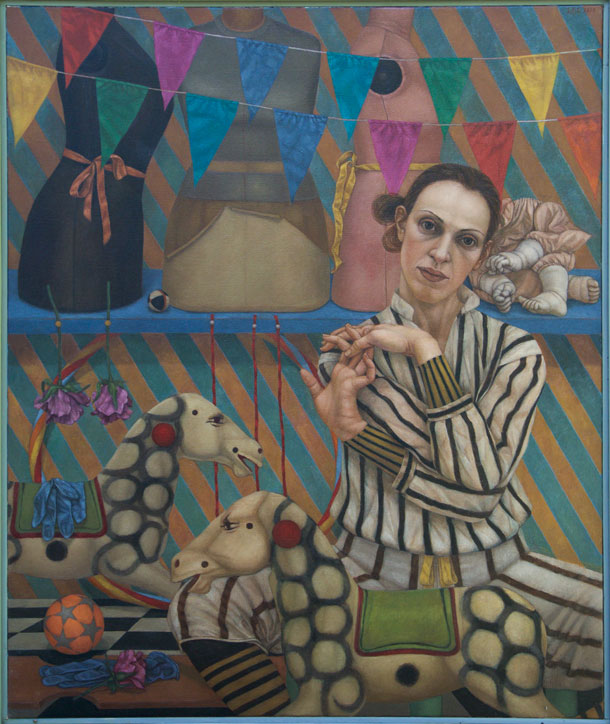
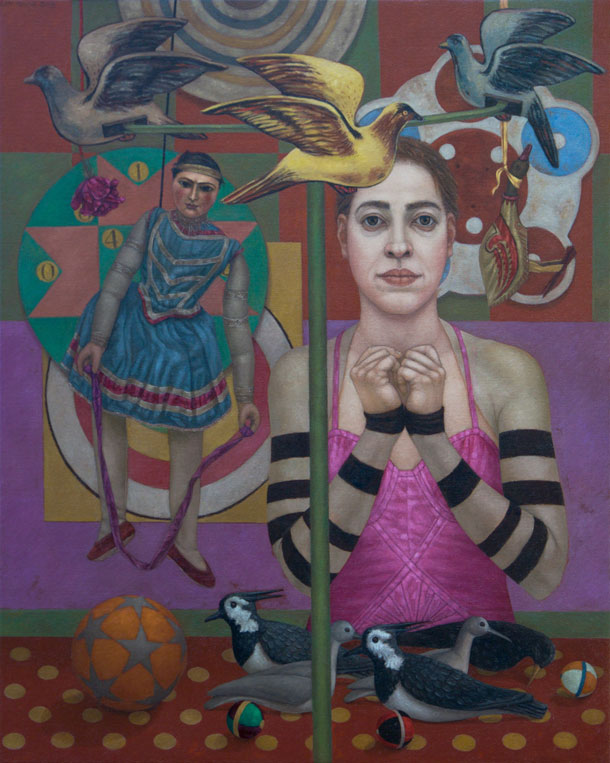
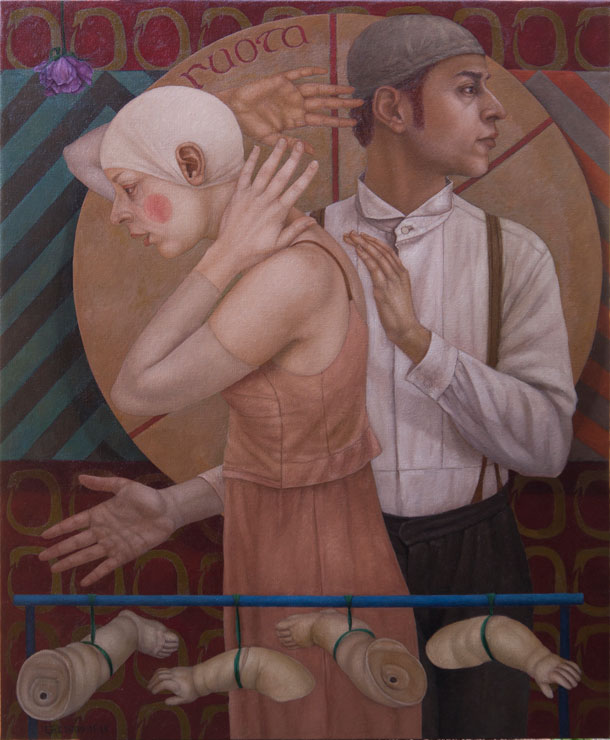
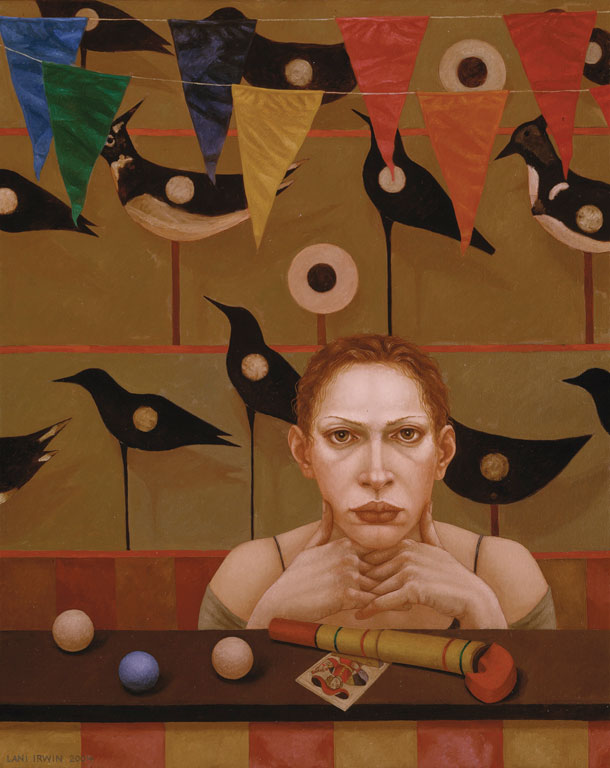
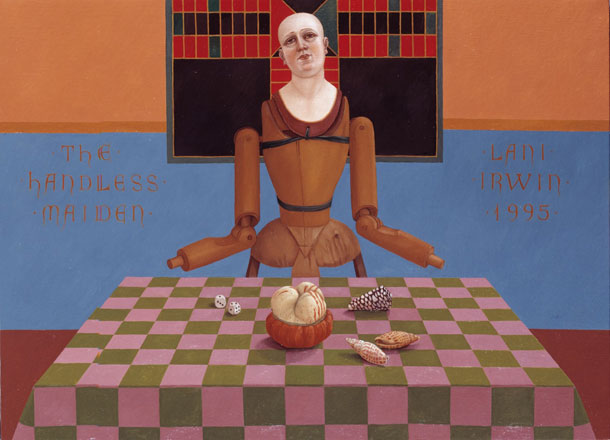
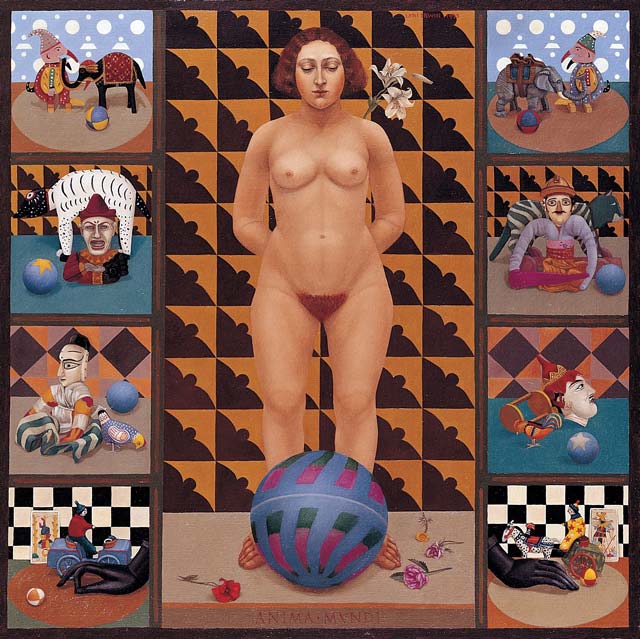
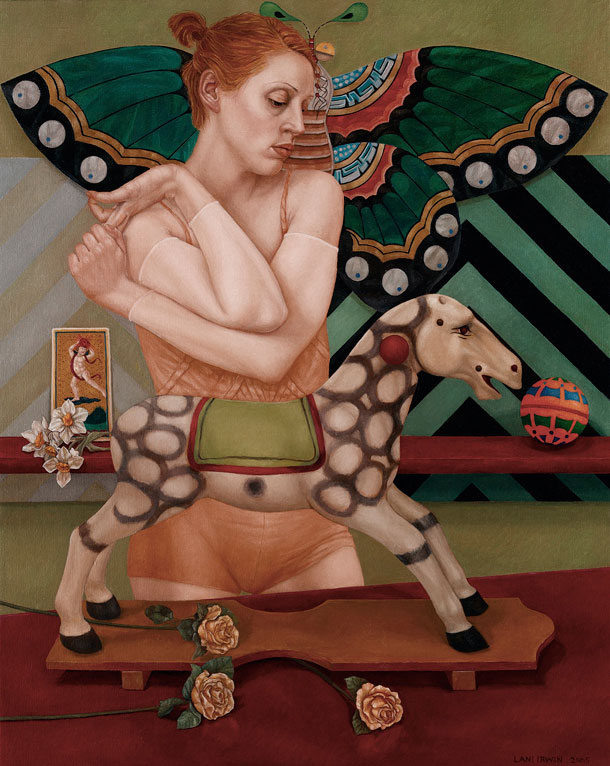
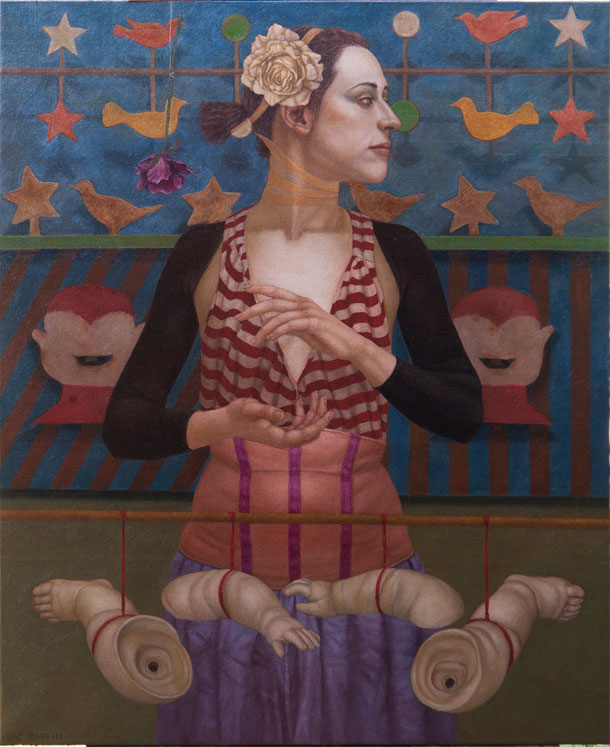
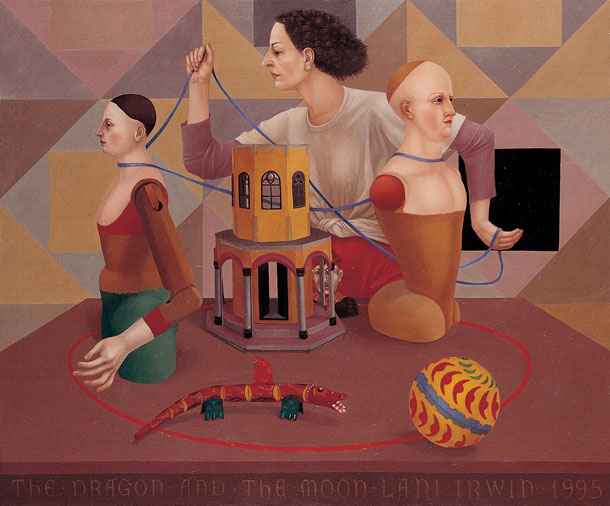

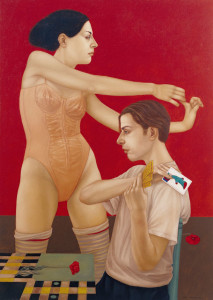

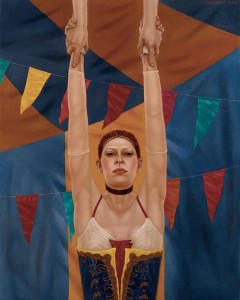
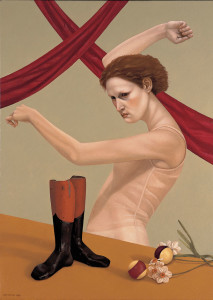
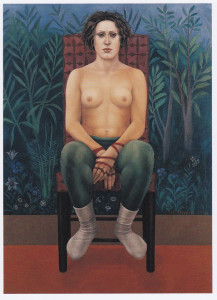

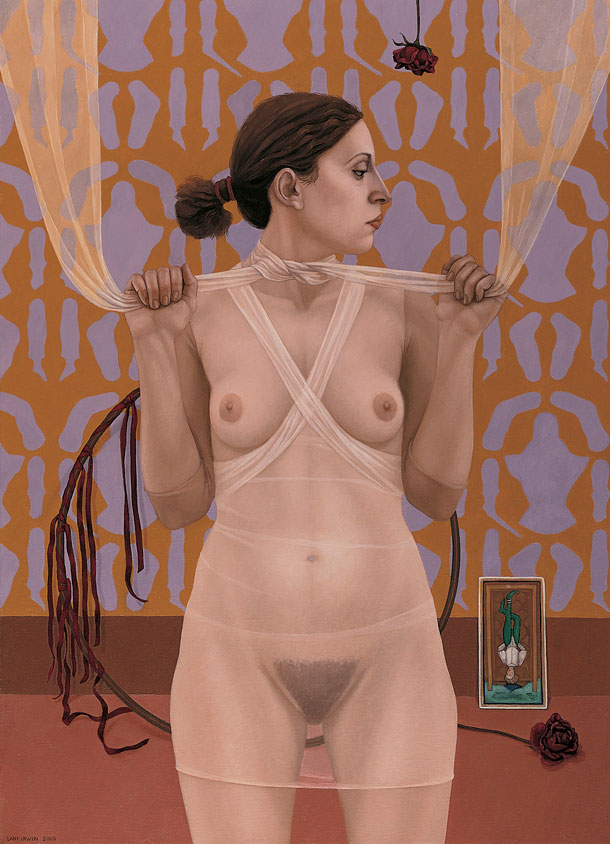
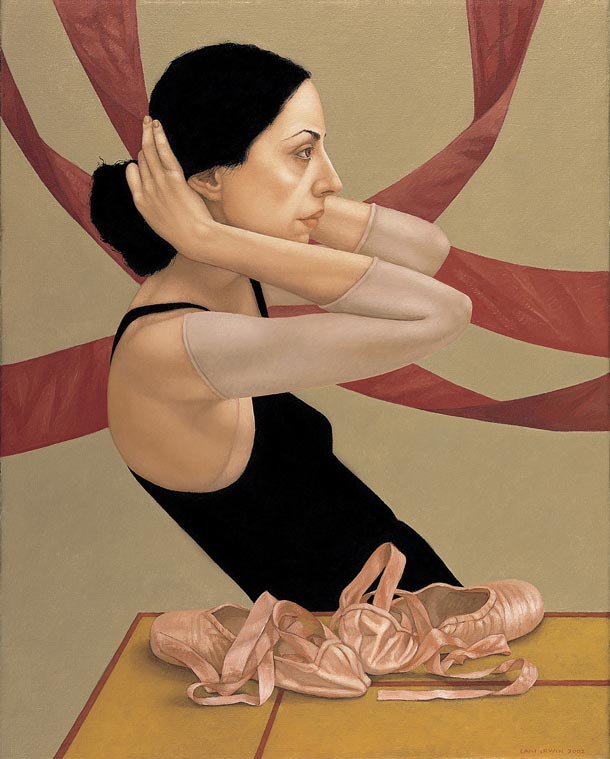

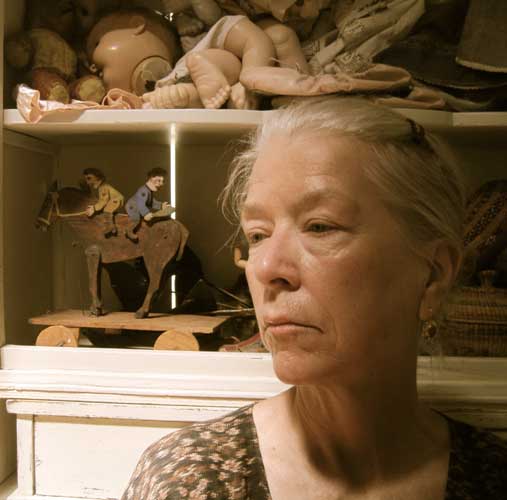




What a fabulous interview – thank you all so much. Thank you, Lani Irwin — for the painting life you describe, and for your articulate honesty and heartfelt clarity. Your work is very beautiful.
A fascinating and most thought-provoking interview. Lani’s articulateness should not be surprising considering her finely articulated paintings, but nevertheless is a great pleasure.
Wonderful article with much insight. Thank you.
Thank you for featuring Lani and her work. The interview is thoughtfully articulated, giving a better understanding of Lani’s work and her development as an artist living in Italy. SACI is proud to have both Lani and Alan as members of the SACI Artists Council and have exhibited their works in the SACI Gallery. They have an upcoming exhibition in here at the SACI Gallery in Florence, Italy, March 7-April 8, 2016. http://www.saci-florence.edu
Thank you for this wonderfully written piece on Lani Irwin — I have seen a few articles about her work in the past, but this article is like the difference between a text message and a hand written letter in the artist’s own words.
Irwin’s description of ‘painting the painting into being’ is brilliant. It seems to me a true way to paint, no matter the subject matter, and the difficult part is, as they say, to know when to stop and then to start again when it feels right. No school I’ve heard of teaches that principle for real.
Again, Thanks, to Irwin and to PP for a perceptive article. I will permanently bookmark this to remind myself to trust my own instincts and make the next move when I can do it without overthinking, second guessing and getting scared about losing a half-good painting…
It is a rare and beautiful thing to learn about an artist whose paintings speak to me as much as her words about them. Thank you for your considerate, yet probing questions that allowed Lani Irwin to allow us to both feel and understand her thought process, the emerging quality of her work and the soul of the artist that exists within. She need not be concerned that there might be a kind of beauty in her work, because they are beautiful, soulful, unsettling and thought provoking.
This was a very thoughtful and insightful interview. It was so clear and well considered and fosters a desire to see the paintings in a show somewhere near and soon.
Wonderfully lucid, intuitive, thought provoking interview! Paintings are inspired and inspiring. I so relate to Jane’s intuitive and deeply within her spirit process. Thank you!
If painting is a search for truth or a greater understanding of our self, I am convinced now more than ever that the truth is Lani Irwin’s paintings.